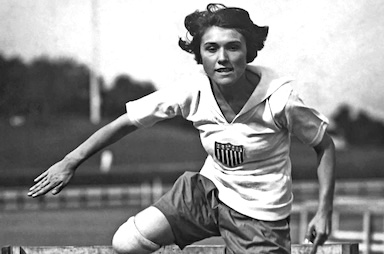
Sport: Track & Field
Born: November 25, 1902
Died: March 20, 1998
Town: Newark, New Jersey
Camille Sabie was born November 25, 1902 in Newark. At a time when women’s athletics were barely supported in America, Camille’s parents, Angela and James, encouraged her to become a schoolgirl track and basketball star at East Side High. She had fantastic leaping and acceleration ability combined with blinding speed. At the age of 17, Camille enrolled at Newark Normal School—now Kean University—and was a star in intramural competition. She showed particular talent as a hurdler, clocking unofficial times that ranked among the best in the world.
In 1920, the Summer Olympics did not include women’s track and field events, which were considered dangerous to the female body. There had been hope that the IOC would change its long-standing rule so, instead, various track organizations came together to form the International Women’s Sports Meet. The first meet was scheduled for Paris in 1922. Tryouts were held on May 13, 1922 at Oaksmere School in Mamaroneck. Historians consider this to be the first “national” women’s track meet.
More than 100 athletes showed up for the competition, including Camille. The first event was the long jump. The winner was Elizabeth Stine, a teenager from Leonia. She was part of a high-school squad—coached by Suzanne Becker—that also won the 440 relay and baseball throw. Camille, who had just graduated from Newark Normal, ran away with the 100-yard hurdles, finishing in a record time of 15.2 seconds. She finished second in the 50-yard dash to Maybelle Gilliland, another one of the Leonia girls. Ten days after the tryouts, Camille won the 100-yard hurdles in a meet at Newark’s City Field and set a world record with a time of 15 seconds flat
And so it was that Camille, at the age of 19, became part of the first American women’s track team to compete internationally, in Paris. One of her trainers at the Normal School, Joe D’Angola, traveled with the team as an assistant. And while all the qualifying was accomplished in bloomers, the team heading for France was supplied with spiffy shorts and shirts design by Spalding—the first track-specific uniforms ever worn by a US women’s team.
Camille’s main competition in the hurdles was fellow American Floreida Batson. Batson, a New Orleans-born Smith College undergrad who had been appointed captain of the US team, broke the world record in one of the qualifying heats with a time of 14.8 seconds. The record didn’t last too long, as Camille won the final with a new record time of 14.4 seconds. Next, she was a surprise winner in the standing broad jump, with a distance of 8’ 1 7/8”—and also finished third in the long jump. Camille ran the anchor leg for the second-place 440 relay team.
Camille received a hero’s welcome when she returned home. More than 1,000 people cheered her at Newark Normal School and she was quickly named Director of Physical Education at the age of 19 at Newark’s John Caitlin Elementary School.
Camille continued to compete in regional meets—and draw enormous crowds. That September, at an AAU competition in New York, she equaled her own world-record time in winning the 60-yard hurdles. More than 3,000 people cheered her on. She also won the 50-yard dash and standing broad jump. A week later, at a meet in Weequahic Park sponsored by the Star Eagle, an estimated 25,000 people showed up to watch Camille shatter the world marks in the broad jump and 60-yard hurdles. She also equaled the American record in winning the 100-yard dash, at 12.0 seconds.
For a brief moment, Camille joined the pantheon of American heroes in what would become known as the Golden Age of Sports. She and her family were featured in lavish newspaper spreads published from coast to coast, and Hollywood expressed interest in her story. It was fun while it lasted, but Camille had a teaching career to get to and she retired from competition prior to her 20th birthday.
Camille earned a B.S. from Columbia University and became a beloved Phys. Ed. teacher at her alma mater, East Side High. She married George Malbrock, also a teacher, and they lived for many years in Newark before moving to Millburn.
In 1981, Camille was enshrined with the inaugural class of the Kean University Hall of Fame. She passed away in 1998 at the age of 95.